The Waitress Musical annoyed me on several levels. I'll state my beef in a bit, but first a brief overview of the story: Jenna is a waitress and pie maker in a small town in the American South. She has an unhappy and abusive marriage. Her husband constantly belittles and manipulates her, even while (eventually) completely depending on her to support their "family." He's probably physically abusive too, but this is mostly implied and not actually spelled out in the musical. Jenna discovers that she is unintentionally pregnant. She doesn't consider ending the pregnancy, but she's not happy about it, which she makes clear on her first visit to the OBGYN. After a chance encounter with her OBGYN, she begins an affair with him. Jenna is torn by her affair, and while she considers ending it several times, ultimately she continues the affair throughout her pregnancy. Meanwhile, Jenna also decides that she wants out of her marriage, but envisions herself running far away from her town, and she needs money to do that. As luck would have it, there is a pie contest in a nearby town and Jenna is a very good pie maker. She decides that she is going to enter the pie contest and if she wins, she'll leave her husband. Unfortunately, due to various circumstances--including going into labor--Jenna never makes it to the pie contest. Instead, while she's at the hospital having her baby, the owner of the diner she works at hands Jenna a card and instructs her not to open it until after the baby comes. Later, we learn the the diner owner has died during surgery. After the arrival of Jenna's baby, Lulu, Jenna finds the courage to tell her husband that she wants a divorce and that he needs to leave. Her lover-doctor is there to help ensure that ex-hubby leaves. Also present at the hospital is the lover-doctor's wife, who is a resident training at the hospital. Sensing the love and trust that his wife has for him, Jenna concludes that they really should end the affair "before anyone gets hurt." She thanks lover-doctor for "taking her to the moon" and as well as "teaching" her so much. He leaves and Jenna finally opens the card that her former boss had given her. Inside is a card telling her that he has left the diner to her in his will. Jenna renames the diner "Lulu's Pies" and supposedly things are just dandy after that. Okay, here's my main beef. This is arguably the story of a woman who jumps from one abusive relationship into another. No, her doctor-lover doesn't physically coerce her or mentally shame her. But he's an authority figure who has taken advantage of a woman at an emotionally vulnerable time in her life. Jenna herself is conflicted. And yes, she's a grown woman who can make her own decisions and be held accountable for them. You can't blame the doctor for the entire situation. But even as Jenna distances herself multiple times, doctor-lover pursues her and shows up at her work. It drove me crazy that this was portrayed as loving concern rather than slightly creepy self-interested manipulation. The doctor's behavior is simply a betrayal of the trust we generally put in medical professionals who will often be interacting with the emotionally vulnerable.
Now, in real life, it is unfortunately common for mistreated romantic partners to jump into other unhealthy relationships. I could almost swallow this story if it were an unfiltered look at humanity; Jenna as the abused spouse who falls into another unhealthy relationship, Dr. Pometter as a human being with a human being's weaknesses and vulnerabilities. But no, This relationship is portrayed as somehow healthy and mutually beneficial. A great learning experience or something. A couple of other minor beefs I had with the show: The relationship between Jenna and doctor is very poorly motivated. There's so little that actually builds up to the affair. It just seemed so implausible. Also, why is it okay for the doctor's wife to know nothing about the affair? Does he deserve his wife's "obvious trust" that Jenna sites as her reason for finally terminating the affair? In a show supposedly about female empowerment, keeping the wife in the dark is just dumb. And stating that they're ending the affair BEFORE it becomes "messy" and "hurts" anyone, completely dismisses the value of the wife's trust in her husband and implies that as long as she doesn't know, it won't hurt her. In reality, she's in a relationship where there are clearly some issues that need to be addressed, and keeping her in the dark is demeaning. Also, I found it ironic that in a show about empowering women, Jenna was ultimately saved from financial ruin by a man. I mean, honestly I liked the crusty, grumpy "Joe" character. But wouldn't it have been nice for Jenna to actually go to the pie contest and prove to herself that she can put herself out there AND succeed? Instead, she never makes it to the contest and then Joe gifts her the diner. I definitely had mixed feelings about that. So is the show worth watching? That depends. The cast I saw was talented and entertaining. The staging was well done and everything looked great and moved at a nice pace. If you want to study all those elements, then by all means, go for it. It's a good example of that. But the music was just okay. I don't mind Sara Bareillis' songs, but most of the music is unmemorable and very similar. Sort of a flowy-pop style with a few belty B sections for good measure. A couple of power ballad-esque songs. But I wouldn't expect you to leave the theater humming any tunes. The few exceptions were the nerdy character Oggie's songs. His songs were very different in feeling from the rest. I also liked Jenna's "Everything has changed" and the recurring "Sugar, butter..." theme. In the end however, I was disappointed by this musical. While I found myself happy for Jenna's character--she left an abusive relationship, found meaning in motherhood, and became a successful business owner, I ultimately concluded that the journey the musical took to get her there was unrealistic and unhealthy.
0 Comments
I like my students to watch and listen to as many musicals and operas as they can. While live performances are usually best, that’s not always practical, so I’ve been happy to find that there are quite a few that you can stream on hoopla. If you don’t know what hoopla is, it’s a digital lending library. A lot of our local library districts provide access with your library card. So, go sign up for a card and start streaming! You can even download to mobile devices to watch while you’re off network. The odd thing I’ve found though, is that things are categorized weirdly. A lot of the musicals are categorized as simply comedies or dramas. So, you can’t just search “musicals” or click on the “musicals” tag and find all of their musicals. In fact, if you do just look at the movies that are categorized as “musicals” you’ll get recommendations such as Madeline’s Sing-A-Long Around the World, and Brainy Baby’s Musica. Not helpful. Which is why I decided to compile this list. Hopefully it will help my students and others to find some of the real musicals they have available. Now, most of these are not my favorite versions. In general, I prefer recordings of stage performances with professional stage actors. When evaluating the quality of a production, there are a few things to know. Usually movie versions with famous actresses and actors are not going to be top-notch, at least as far as singing is concerned. The recent-ish movie versions of Les Misérables, Into the Woods and Beauty and the Beast are full of bad singing. Sometimes you’ll come across recordings where the cast includes some pop culture icon that are just bad (hello David Hasselhoff in Jekyll & Hyde). But that’s not always the case. Hugh Jackman in Oklahoma! was great. But then, Hugh Jackman’s singing in Les Misérables was problematic (Hugh Jackman is not a tenor and really shouldn’t have been singing that role). I find that there’s always something to learn, though. The acting and singing can be evaluated separately, and you can ask yourself what about each made it good or bad. It can also be interesting just to see what singing styles were popular during which time periods. And without farther ado, my list of 30+ musicals, operas and concerts worth watching on hoopla. MUSICALS: Annie (The 1999 movie version) Babes in Toyland (The 1961 Disney movie is an adaptation of the original operetta) Bride and Prejudice (An interesting introduction to Bollywood and Indian music) Camelot (The 1982 Broadway stage revival) Chicago (The 2003 movie version) Cinderella (The 1965 recording of the Roger’s and Hammerstein musical) The Fantasticks (The 1995 movie version) Fiddler on The Roof (The classic 1971 movie version) Guys and Dolls (The 1955 movie with Frank Sinatra) Gypsy (The 1993 made for TV version with Bette Midler) Gypsy (The 2015 Live from the Savoy Theater version) Hair (The 1979 film based on the 1968 Broadway musical Hair: An American Tribal Love-Rock Musical) Into the Woods (The original Broadway production with Bernadette Peters) Jeff Wayne's Musical Version Of The War Of The Worlds (2012) Jesus Christ Superstar (1973 with Ted Neely) Jesus Christ Superstar (2000 with Glenn Carter) Joseph and The Amazing Technicolor Dreamcoat (2000 version with Donny Osmond) Love Never Dies (2012, Andrew Lloyd Webber's sequel to the Phantom of the Opera) Man Of La Mancha (The 1972 film adaptation of the Broadway musical) The Music Man (The 2003 made for television version with Kristin Chenowith) Once Upon A Mattress (The 2005 movie with Carol Burnett) Phantom Of The Opera (2011 recording at The Royal Albert Hall) Rent (2005 movie version with Idina Menzel) “Shirley Temple’s Storybook” presents “Babes in Toyland” (1960) The Sound Of Music Live (2015) OPERAS (including documentaries): Becoming Traviata (2013 documentary featuring Natalie Dessay) The Paris Opera (2017 documentary featuring, Benjamin Millepied, Bryn Terfel, and Philippe Jordan) Tosca’s Kiss (1984 documentary, memoirs of the Italian opera by the singers and musicians of the Casa Verdi, Milan) La Traviata (1983 production with Placido Domingo Rigoletto (1946 film starring Tito Gobbi) CONCERTS: Les Miserables (2010, The 25th Anniversary concert version) A Celebration Of Peace Through Music (2015) Rocktopia: A Classical Revolution - Live From Budapest (2016)
The second song is the main theme from "In the Hall of the Mountain King" and I've added some fun words to it. This is a favorite with my youngest students because I use it to teach the concept of "accelerando." Each repetition of the theme I speed up little by little until we're singing it ridiculously fast and giggling. Hopefully the children you sing it with will like it just as much!
That's much easier said than done. I know. For years it mystified me why I could perform on a stage in front of hundreds of people and not get nervous, but I'd crash and burn due to nerves during auditions and juries. I chalked it up to "the pressure." It took me years to realize that "the pressure" was largely composed of my focus on my vocal deficiencies and trying to control and fix those rather than focusing on my strengths. Yes, of course in an audition you're singing for someone who will notice your mistakes--they're not sitting there wanting to be entertained and they are there to compare you to others. But you don't have to compare yourself to others. This was one of the big differences for me between performing and auditioning--in a performance I wasn't busy comparing and measuring myself against others. Additionally, you have no control over what you haven't learned to do well yet. And most of the time you don't know what a director is looking for and you can't really control that. So why not go into an audition saying to yourself "You know what, I do this one thing really well, and if I show them that I can do this one thing really well in this audition, I'll consider that a success." I used to think that the key was just focusing on one thing at a time and I used to say to myself "Here's this one thing I really struggle with. In fact I've been struggling with it year after year and I kind of feel like I'm banging my head against a brick wall, but if I just manage to that well in this audition then I'll be happy with my performance." I also used to think that the whimpy non-progressing way to learn was to focus on the things I felt comfortable doing and thought I did well. So i didn't. I tried to tackle everything I thought was wrong with my voice. I have learned that you actually make more progress when you're kind to yourself. Focusing on your strengths and the positive doesn't mean that you won't try to learn new things. It means that you're a lot less likely to get hopelessly discouraged. Vocal self-consciousness pervades our society. People try to "fix" their speaking voices and their singing voices--or they simply avoid speaking and singing. But learning to sing isn't really about fixing anything. It's about molding and shaping what you have. I'm always a little sad when I look around my church and notice how many people aren't singing. People often tell me that they "can't" sing. In most cases, this is simply untrue. Maybe you don't know if you're singing in tune or not, maybe you know you can't hit high notes, but neither of those means you can't sing. I wish that more people gave themselves permission to sing imperfectly because I'm afraid that all of us are getting too little exposure to real unfiltered human sound. I know moms who won't with to/with their kids. that's just heartbreaking to me. You can't sing in tune? That's okay. You think your voice is scratchy or screechy? That's okay. Too quite? Fine. Breathy, wispy, shaky? All okay. I mean, if you want to you could learn to fix those things, but there is inherent beauty in human vocalization, and I for one, want to hear more of it.
When it come to singing, I have a few core beliefs. First, singing is a physical activity requiring mental and muscular coordination, and thus can be learned. While some people might have more of a predisposition for music and singing than others, everyone can improve. Absolutely everyone. It is definitely much harder for some people than others to learn this skill--think about running, crocheting or cooking. Those things are going to be harder for some depending on who they are. Learning to sing really depends on how much time and effort you want to put into it; some people won't care enough to put in the required work, and that's fine (In much the same way I have no desire to improve my basketball skills. But I could--if I really wanted to. I just don't. (: ). But, if you really want to learn, and you're afraid you can't because you weren't "born with it," I'm talking to you: You can!
One thing that people don't often understand is that healthy singing requires that you use your whole body as an instrument. I strongly believe in healthy, full-body singing and teach accordingly. Many of my lessons focus on developing body awareness and mindfulness while singing. For example, when my now-husband and I were dating he asked me to give him a voice lesson. I tried for several minutes to explain how he could lift his soft pallet. My first few attempts were unsuccessful, but I kept going, approaching my explanation in different ways and with different examples. Finally I had him breath in on an inverted "K." It worked! His eyes got big and he said "I didn't even know that part of my body could do that!" A lot signing breakthroughs hinge on becoming more aware of how your body works to produce sound, so I focus on both mechanistic explanations and physical exercises to develop that awareness. I believe in loving the voice that you have and developing it to it's fullest potential rather than trying to sound like someone else, so my lessons are extremely individualized. I have detailed written plans for each of my students and I involve them in the planning process so that I know we're going the direction that s/he wants to go. I spend a lot of time planning my lessons. Even so, I allow for flexibility, and each lesson for each student will be different. I focus on their individual challenges and interests. I choose repertoire based on the individual's vocal type and personality. And while I believe in flexibility, I also believe in making noticeable vocal progress, so my student's lesson plans will always have a larger, measurable goal that we are working towards. Lessons leading up to this goal will methodically cover all of the techniques needed to reach it. I also believe that it's generally easier for children to learn "music as a second language" than adults. In much the same way that children can pick up languages more readily than adults, children's growing brains are in the perfect state to absorb and learn to recognize musical patterns. Adults who have little to no exposure to singing as a child are generally my students who are challenged the most learning to sing (but they do!). So while I don't teach intense classical technique to children (I believe that children do not need to sound like adults to sing beautifully and be appreciated), I do work with children and I love it. I think voice lessons are so very good for children. I focus on basic musical concepts, gentle singing techniques and building confidence with children through musical games and learning repertoire. So that's a little about me as a voice teacher. Feel free to peruse the blog if you want to know more--I share many of my teaching techniques and answer musical questions here. And if you're in Fort Collins and interested in voice lessons you can schedule them here. I coach both singers and public speakers, and I have been asked whether a voice can be deepened so many times I've definitely lost count. Men think women find low voices more attractive, women think they'll be taken more seriously with lower voices--and they're not wrong. Margaret Thatcher was famously advised to lower her voice in order to be elected, and took lessons with Lawrence Olivier to lower her pitch and "develop a calm authoritative tone." Research has repeatedly shown that men and women with low voices are viewed with more leadership capacity, and even as physically stronger than their high-voiced counterparts. Women remember more easily and prefer men with low voices. Women even prefer their female leaders to have masculine voices. And I guess that tells us why this questions keeps being asked. So, what's the answer? If you want to, can you lower your voice? The short answer is, yes, you can. But the real question you might ask yourself is, should you? I've written about vocal dysphoria before and I always encourage my students accept and be comfortable with their natural voices. Many problems can result from artificially manipulating your voice to sound lower, ranging in seriousness from simple vocal fatigue to actual vocal injury. The truth is, the size and make-up of your larynx determines your most natural speaking range. Think violin v. cello. One is bigger and therefore deeper. The violin will never sound like a cello. Are you disappointed? Don't be. Because while I wouldn't encourage you to actually lower the pitch of your natural speaking voice, there are things that you can do to influence the perception of your listeners. There are many factors besides frequency/pitch that influence what we perceive as a "deep" sound, and these can be healthily altered. Let's start out with what NOT to do. If I were to ask you talk to me like Sean Connery, James Earl Jones, or Santa, here's what you'd probably do:  1. You'd create a "yawn" space in your throat or pull your tongue back (or both). 2. You'd drop your chin, maybe even smashing your neck a little. 3. You might push your lips forward. In the case of a Sean Connery imitation you'd probably lock your jaw into sort of a slack open-ish position. Here's what you're doing: You're depressing your larynx and widening (the yawn or slack jaw) and/or extending (the puckered lips) your resonance chambers. This will result in a lowering of your pitch and a more "full" sound. Not all of these techniques are bad per se, but taken to extremes they all lead to vocal fatigue--a.k.a. hoarseness and voice loss. The lowered larynx is especially problematic. You're placing a huge amount of strain on some pretty small muscles--the geniohyoids, sternohyoids, and sternothyroids. It simply isn't sustainable. In the words of Richard Miller "The history of the low-positioned larynx is a long and depressing one." (National Schools of Singing, pp. 221) Get it? Depressing? Isn't he punny? :) So now you know that the way you instinctively mimic your deep-voiced idol is wrong because it will wear out your voice. Besides this, weirdly manipulating the shape of your resonance chambers (i.e., mouth and throat) most often results in a somewhat garbled and "cloudy" sound. It's much harder to understand someone who is speaking with a lowered larynx and puckered lips. Another consequence of speaking lower than is natural to your relaxed larynx is that this results in vocal fry. You know, that weird gravelly Kardashian I-don't-really-care-about-what-I'm-saying-and-I'm-not-interested-in-anything vocal quality? That's vocal fry. And many vocal professionals have described it as an epidemic. If you're auditioning or interviewing for anything that has to do with speaking or singing, I guarantee you that they'll notice you frying-out at the end of your sentences. And while I've generally seen articles dedicated to the impact vocal fry has had on women, in my experience vocal fry affects men as well. Purposely lowering the pitch of your voice will lead to vocal fry. All right then, what should you do? The first step is to identify the factors besides pitch that make up a deep sound. The first is vocal color. A dark or bright color exists apart form the pitch itself. High pitches can sound dark and low pitches can sound bright, depending on how they are produced. Vocal color is largely influences by your vocal placement. I talk about it a bit in this blog post, but basically you don't want to sound like Santa or the Wicked Witch. A nasal sound is generally considered bright and irritating. By playing around with your placement on a pitch that is in your comfortable not-too-low range you'll find that you can significantly alter your vocal color and create a deeper, richer tone. Think Golden Mean on this one. Go for something in the middle, and avoid the urge to overly "darken" your sound. Second, you want to avoid a breathy sound. Not only can it be difficult to understand, it's vocally inefficient and can be fatiguing. Neither do you want a strident, tense sound to your voice. Relax and aim for a clear, consistent sound. This will come across as confident but not aggressive. This trait is all about balancing your airflow with your muscular manipulation. One thing that might help you explore breath effeciency and balance is this. And last but not least is vocal line. I'll explain what I mean by this because it encompasses a couple of things. The first thing I mean when I say vocal line is the flow from one word to another. English is kind of a choppy language when compared to others. I've studied and spoken French for years now. When I began to really master the French "accent" I realized that this referred to not only my pronunciation, but the flow from one word to the next. When I started to pay attention to my airflow while I was speaking, ensuring that it was more of a continuous stream and much less puffy and choppy, my accent improved considerably. I also developed a more melodious "line" to my speech. I have noticed that English speakers will mellow, attractive but not breathy voices speak with more continuous air flow than those who do not. You still want to be understood, so ultimately it's not a good idea to smoosh your words together too much, but it doesn't hurt to play around creating a little more connectivity in you vocal ine. The other thing I mean when I talk about vocal line are your infections. "Up-talk" is an example of an annoying vocal inflection habit, and it's become more and more common. If a lot of what you say ends up sounding like a question, you're probably up-talking. It tends to come across as youthful and uncertain and could be undermining your interviews, presentations and auditions a lot more than the pitch of your voice. I often find that people who are going for "sincere" can up-talk as well. But sometimes it can sound more like you've just memorized what you're saying because the inflection isn't normal. This combined with breathy whisper-talking is one of my pet peeves. I have hard time hearing the words behind the tone if this is the way you're speaking. Aim for smooth confident statements. This can be achieved through deliberate inflection and smooth consistent airflow. To sum up, if you want to develop a deeper more attractive voice, don't focus on the pitch. Instead, work on you vocal placement, breath consistency and inflection. It's not easy to change the way you talk--you've been doing it your way for years--but it is very possible. So play around. Develop an attention to vocal qualities other than pitch and you'll be well on your way to a more confident successful sound.
Why Game-ify? Scholars have an answer for that too. "Gamification has gained traction in recent years as an effective way of engaging users to perform actions in contexts that would otherwise be considered tedious and undesirable." Gianetto et al. from Issues in Informing Science and Information Technology. So motivation and engagement are a big part of why you might want to implement learning games and activities into your music lessons. According to Dr. Gwen Dewar, play can actually stimulate the growth of the cerebral cortex and promote creative problem-solving. You can read more about that in her article here. I've been a fan of game-based learning for a while, but it's nice to know there's research supporting what I'm doing. :) Two of the most tedious and frustrating tasks I encountered in my music education were dictation and sight reading--and all of the solfege, intervals, rhythms, and Kodaly hand signs that went along with it. Sometimes it would seem easy and intuitive and then I'd encounter something that my brian just didn't want to compute. I seemed to be constantly practicing. In fact, one of my college roommates has told me that she saw/heard me solfeging and doing the Kodaly hand signs in my sleep. Talk about tedium, haha! Kids especially respond well to being "tricked" into learning (although I play games with older students too!). In my last post I created a Chutes and Ladders game to teach three really basic intervals: unison, major second, and major third. It's quite impressive to me how easily children pick up on the intervals and then seem to even forget they're practicing them as they focus on the game. My four year-old kept begging to play the game. Well, I wanted to add to students' interval repertoire, so I've created Whoops! It's basically a modified Sorry! that uses intervals to tell players how many spaces they can move. I've kept unisons, major seconds and major thirds, and added perfect fourths and fifths. It can be played with 2-4 players/teams, and you can use the intervals either visually or auditorily. You can control the length of play by choosing how many player pieces to use. I also think that this makes excellent practice/homework, especially if the student has a parent or sibling that can help him/her by playing or singing the intervals. You can download the full game below, and let me know how it goes!
One of my favorite music teaching tools is melodic contouring. This is basically a line depicting the sequence of pitches in a melody. You can figure out the basic shape by playing dot-to-dot with the notes. So, for example, "Jingle Bells" would look something like this: When working with melodic contouring in one of my activities, I find that it can be helpful to exaggerate the movement of the notes (I'll include activity sheets at the end of the post). So again, "Jingle Bells" ends up looking something like this: How can you use melodic contouring? Here are a few ideas:
I like teaching with melodic contouring because it's fun, versatile and takes little to no preparation. You can print out these activity sheets, or simple draw a line on a white board (also included in the printable are some large versions of the Bunny-carrot, Letter-mailbox, Bee-flower etc. illustrations that you could use on the white board if you want). Easy peasy! Hope you enjoy! Why was Vivaldi stuck outside?Because he couldn't find the right key!!!
This is a joke from my violin book primer Super Strings! At the end of every chapter there's a homework page, and on every homework page there's a fun joke--I find that this encourages children to look at their homework page throughout the week. :)
In my last post I wrote about the teaching strategies for rhythms and violin strings names that I use in Super Strings! Today, I thought I'd explore some of the ideas behind bowing and fingering that I use in the book. So again, my goal throughout the violin book to keep young minds active and learning. Bowing correctly is tricky and can be very frustrating for beginners. When kids get frustrated bowing, the bows often turn into make-shift swords. At least that's what I've found. For me, one of the best strategies has been to channel these sword-fighting impulses into games that actually help with bowing technique. It's also helpful to begin with some silent bowing activities so that both the parent and student retain their sanity in the first few weeks of bowing.
I like to teach the bow grip with a "bunny" hand shape. This is easy for young students to remember. I also use decorated toilet paper rolls and rubber bands to create a practice bowing tube. This helps students gain the muscle memory for bowing without the inevitable scratchiness of the first-time bower. In one activity that I like to do with my students I call out a string name and have them "bow" it (the toilet paper tube will rock back and forth so students can "play" each string). As they bow up and down through their tube I'll play the string for them and help them begin to tune their ears to the pitches of each string.
After we've got the bow hold basically down, I like to play a few games to solidify it. I'll play "peek-a bow" (a game where students spot a bow-grip error), "Vivaldi says" (A Simon says variation), and "pass the cup." You can see in the above illustration that students are basically supposed to pass a cup back and forth using their bows--the key to this game is that they have to hold the bow correctly while doing so. This game really curtails sword-wacking impulses while also teaching bow control.
Another way to keep students engaged is through games and activities. In the activity "Program your practice" above, students use the binary code to spell short words or their names. The zeros and ones translate into open strings and first finger notes. I've had students who love this so much that they never want to move on from their first finger!
|
AuthorSinger, writer, mother, yogi, wife and chocolate enthusiast. Archives
January 2022
Categories |
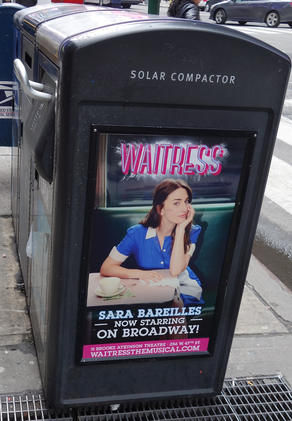




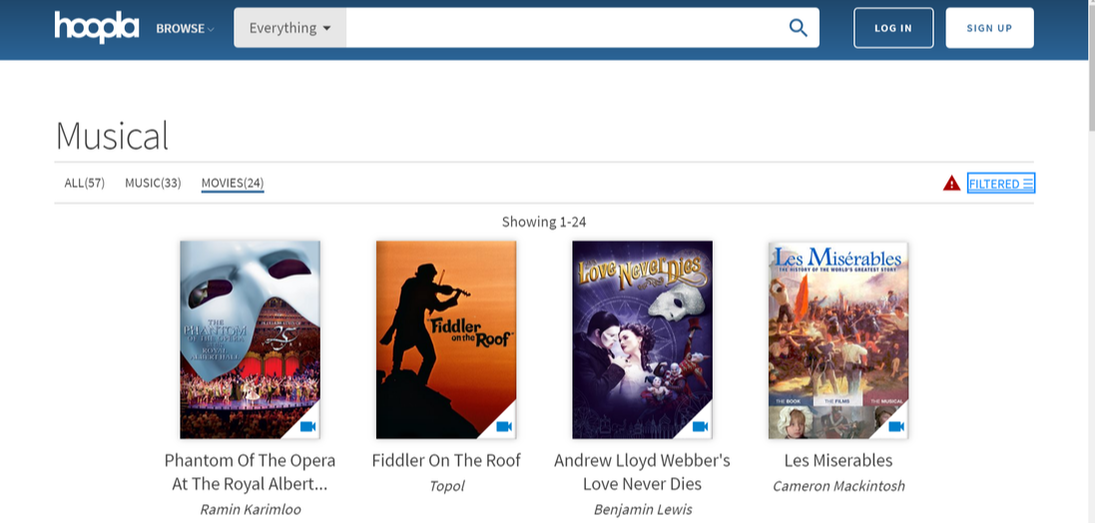
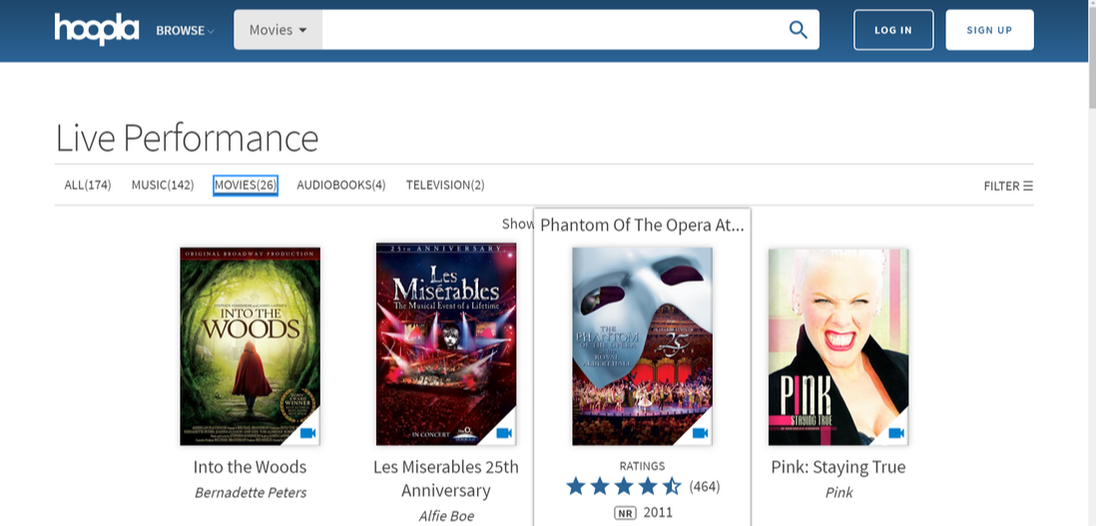
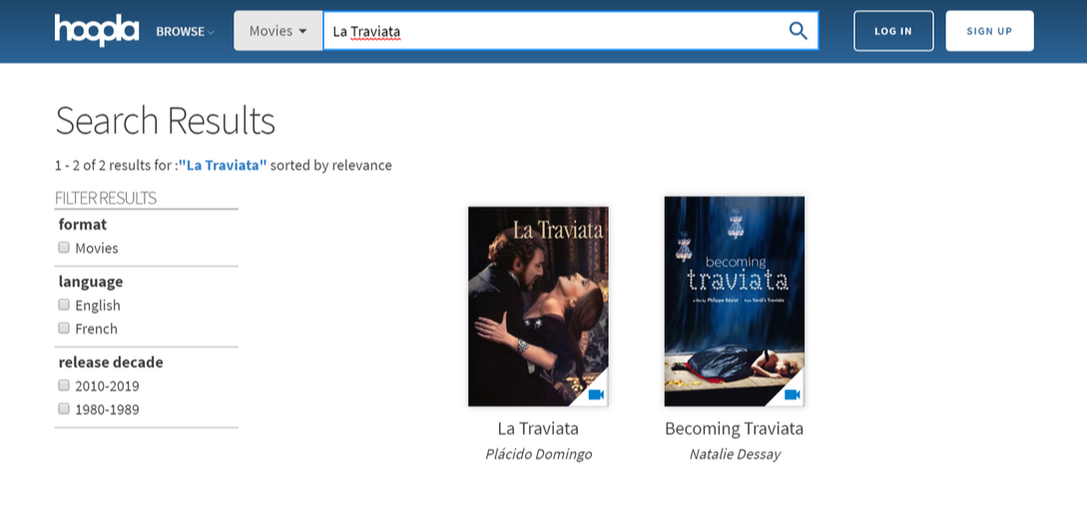
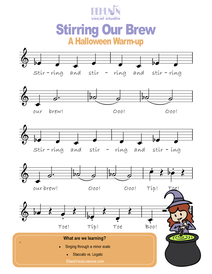
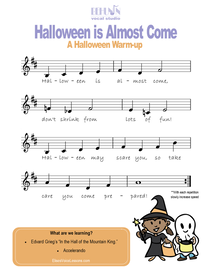
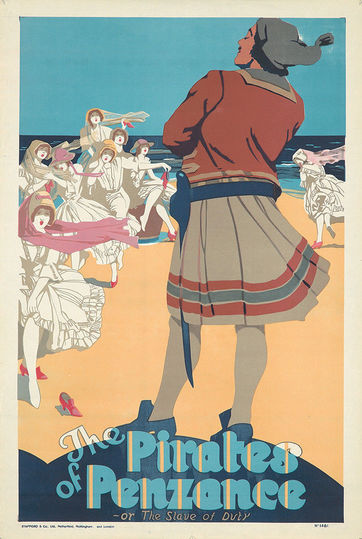
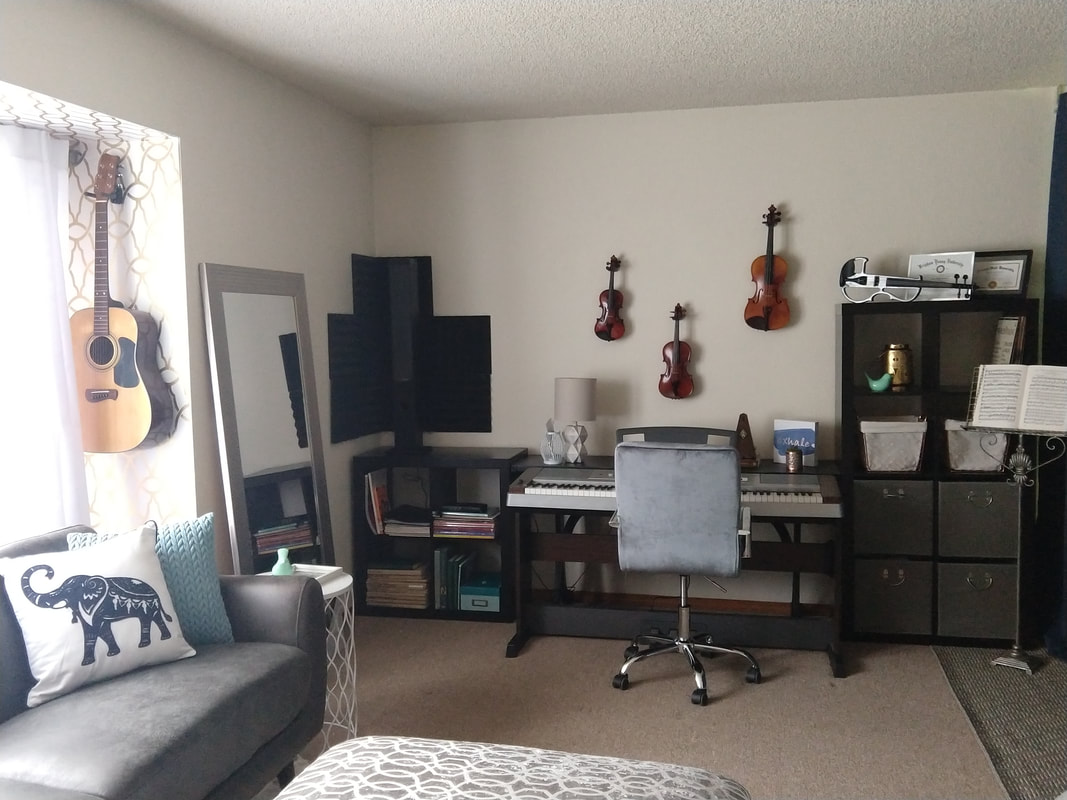

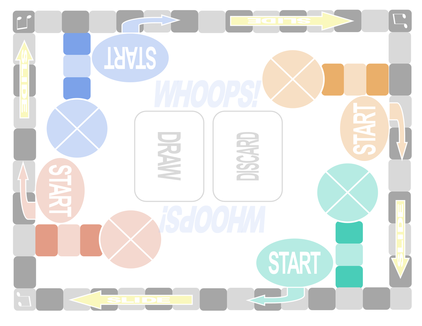
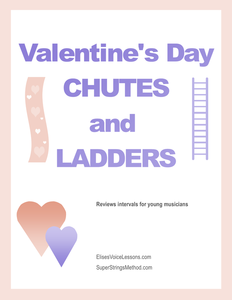

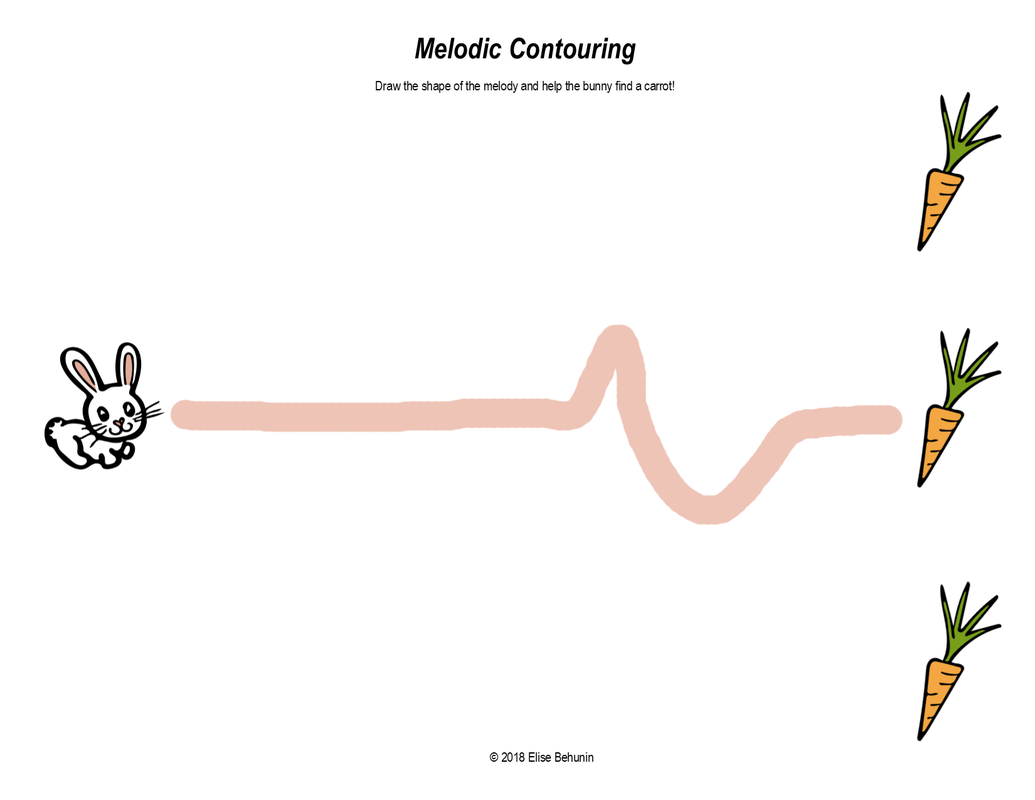

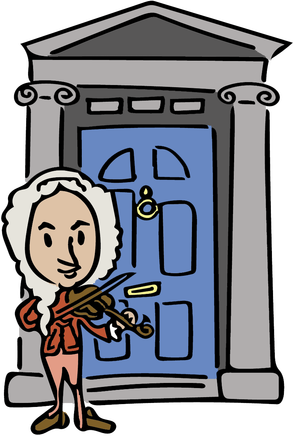


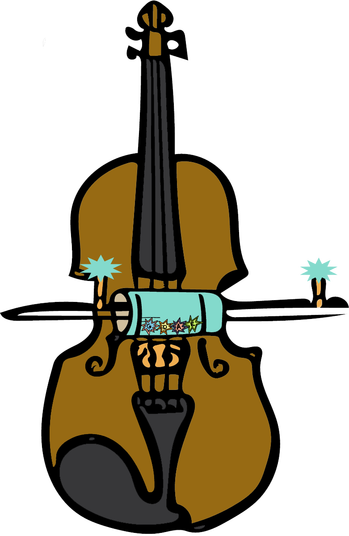
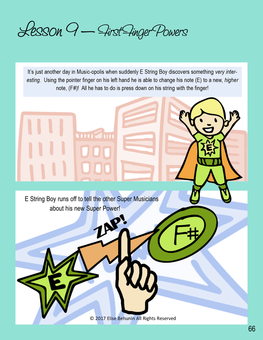
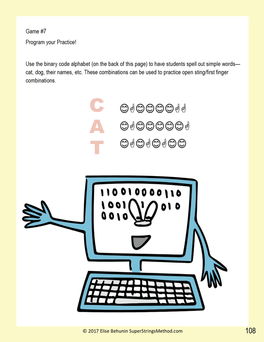
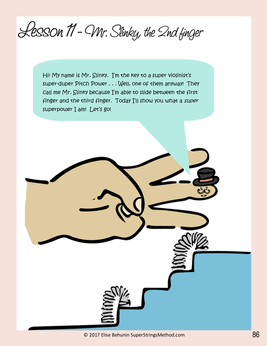

 RSS Feed
RSS Feed